#Honestly perhaps Alfred is more mentally effected than the others seeing as he's right on top of the cave all night
Text
Twisty Turns and Horror
“Every story ever told can be broken down into three parts. The beginning. The middle. And the twist.” — Jack Black as RL Stine in Goosebumps
I want to talk about twists.
Specifically, I want to talk about two primary types of twists in the horror genre, and how and when each can be employed -- and the pitfalls of both.
But first, a caveat: What do I mean when I say “twist”?

A plot twist occurs when the audience’s expectations are subverted.
Based on the existing information in a storyline, a reader or viewer expects a certain outcome. A twist occurs when something unexpected happens instead. But a twist is not a mystery. A mystery presents a question -- who did it? how? what happened? -- and then challenges the audience to figure it out before the characters involved. A good mystery requires you to lay down foreshadowing and set up all of the clues, providing red herrings as necessary to distract the audience, before tying it all up at the end with a neat bow.
A twist, on the other hand, does not necessarily require such setup and foreshadowing. And, indeed, some of the very best twists in the genre do away with such things entirely.
So with that out of the way, let’s talk about the two types of horror twists -- what I’ll refer to as The Hitchcock Twist and The Shyamalan Twist.
By nature of the subject matter, this will be spoiler-heavy, so follow under the cut!
Alfred Hitchcock and M. Night Shyamlan are two directors who made their careers from creating movies with a twist. Although plenty of other horror directors employ the same techniques, the careers of Hitchcock and Shyamalan are defined by twists in a way others are not.
But -- however much he may try to emulate him with his signature on-screen cameos -- Shyamalan trades in a very different type of twist than Hitchcock. Taken at a plot level, the two approaches to storytelling are actually completely opposite.

A Shyamalan Twist Occurs at the End, Reinterpreting Everything That Came Before
Let’s briefly review Shyamalan’s twists to see what they have in common, shall we?
The most famous -- in The Sixth Sense, we discover at the end that the character played by Bruce Willis has actually been dead the entire time, and that he is just another of the ghosts the little boy can see.
In The Village, we learn that what appears to be a rural pioneer settlement is in fact a modern commune that’s been lost to history for a couple generations, and the monsters are manufactured as a way to keep the inhabitants in line (and from escaping).
In Unbreakable, we discover that the story isn’t just the hero origin story for Bruce Willis’s character, but the origin story for the villain Mr. Glass -- who was responsible for the accident that set the hero on his journey in the first place.
In The Visit, we find out that the kids haven’t been staying with their grandparents at all, but rather with a pair of escaped and murderous mental patients.
What do all of these have in common? The twist is revealed at the climax of the film, and it acts to completely reinterpret the events that came before it. You’re left leaving the theater to think about everything that came before the twist, and try to find a way to piece it all together. All of your expectations up to the climax have been subverted, and you’re left to do the work of figuring out how to make sense of what you’ve seen (or not, of course - perhaps you leave the theater without ever thinking about it again).
Done well, this twist can be incredibly powerful because it invites interaction from the audience even after the story is finished. The twist introduces new questions that it doesn’t answer, and conversation can spring up around finding solutions for it -- either within the text itself, or contemplating it in a larger context. Done well, a Shyamalan twist can lead the audience toward introspection and create a haunting effect.
Done poorly, of course, it can feel cheap, cheesy, unearned, or just downright stupid. That’s the greatest risk of the Shyamalan twist -- it can leave the audience thinking, “Who cares?”
Of course, Shyamalan didn’t invent this sort of twist -- it’s just what he’s best known for -- and there are tons of other examples out in the wild. Here are a few to consider:
The Twilight Zone -- When I’ve delivered this talk before (if you can call “rambling about movies to my coworker” a talk), it’s been pointed out that this twist was really codified first by The Twilight Zone, and I should really call it a Serling twist. Well, I’m not doing that for two reasons. One, because Serling never tried to draw a direct parallel between himself and Hitchcock, so Shyamalan is really inviting himself to this discussion. Two, because The Twilight Zone uses the formula a little bit differently.
First, not every Twilight Zone episode had a twist ending (although the most famous ones did, probably for the reason I mention above -- people like to talk about surprise endings, and they stick in the memory). But more importantly, the twists were the story. The sci-fi/horror shorts were structured like jokes where the twist was the punchline, often crafted to deliver a particular message or parable. Most of the episode existed to set up the twist, with little time spent on extraneous plot and character development. Thus, Twilight Zone stories are more clever than shocking. Still, they are a treasure trove of storytelling to study, and they make for a wonderful compare/contrast with Shyamalan’s films.
Other notable Shyamalan-style twists:
Fight Club, where we learn that Tyler Durden is not real, but rather the alter-ego of the seemingly meek and unnamed narrator.
Memento, where we learn that the film’s core mystery has been solved numerous times, only to be forgotten -- and that the main character is being manipulated every step of the way.
Orphan, where we learn that the titular orphan with homicidal tendencies is in fact a grown woman with a peculiar form of dwarfism who is manipulating the families who adopt her. (the movie is better than that plot synopsis makes it sound, I promise)
In Hide and Seek, we learn that the little girl’s evil imaginary friend (at times implied to be a ghost) is in fact her father’s alternate personality.
There are, of course, lots more. There are also some near-misses. For example, despite its bleak “gotcha”, the ending of The Mist -- where the main character mercifully kills his fellow survivors before running out of bullets to use on himself, only to find that help was just around the corner -- doesn’t quite count. It’s a shocking and heart-wrenching twist, but it doesn’t fully redefine the film that came before it.
Pros to the Shyamalan Twist:
Gives your audience something to think about long after they walk away, generating discussion and hopefully that haunted “I need a minute” feeling to process the story.
Invites a second watch/read in order to pick up the clues and pieces and see how the story unfolds differently after you know the ending.
Cons to the Shyamalan Twist:
Can feel cheap or un-earned if the twist makes the events of the film no longer seem to matter (eg, “it was all a dream!”)
Often ends up relying on ableist mental health tropes (split personality, escaped lunatic, etc etc.), so please do something new with it
Can completely fall apart if the ending is spoiled ahead of time, making it difficult to succeed in a post-internet environment.
All in all, the Shyamalan Twist can be a powerful storytelling tool, but it can also fall flat on its face. The thing that will make it succeed is if the other elements of the story, especially the characters, are compelling enough on their own to make the reader want to know more.

A Hitchcock Twist occurs early in the film and changes the rules of what you’re watching
A primary characteristic of the Hitchcock twist is that it happens early in the story -- about 1/3rd to 1/2 of the of the way through. It sets up a premise, invites you to get invested in the characters and their situation, and then pulls the rug out from under you by dramatically changing the movie into a different type of story altogether.
For example:
In Psycho, the first 47 minutes of the 109-minute movie are all about Marion Crane, a woman who steals money from her job and skips town before ending up at a seedy roadside motel. These 47 minutes spend a lot of time building Marion’s character and setting up what could be a crime thriller...until she is abruptly and violently murdered, and the narrative shifts over to the killer.
In The Birds, a socialite and a lawyer spend almost half the movie developing a relationship, from their meet-cute to the ensuing quasi-romantic stalking, the weekend getaway, meeting the locals, befriending the family, attending a party. It honestly feels like a romance (with a few creepy details) right up until a flock of birds starts attacking party-goers.
In Vertigo, the main character is a retired police officer turned private investigator who is hired to spy on a man’s wife, only to fall in love with her, a situation made complicated by her apparent madness and/or possession by a dead ancestor. This madness drives her to commit suicide. Except then the movie keeps going, and we discover that everything up to that point (2/3rds of the film) was actually a complex setup to disguise a murder...a revelation that honestly takes a backseat to Scottie’s newfangled, creepy obsession with the not-actually-dead girl of his dreams, which then ends in a new murder. It’s a convoluted story that’s much easier to watch than to explain, but it’s a wild ride from beginning to end.
What do all of these Hitchcock films have in common? They set up one storyline, spending lots of time developing the characters and progressing the plot, only to take an extremely sharp turn. Some might argue that Hitchcock thrillers are just very slow burn, taking their time to luxuriously build up to a crescendo, but I think it goes deeper than that -- some of these movies abruptly change genre.
In no instance is this as self-evident as in The Birds. The effect of watching it is akin to what might happen if you made a Lifetime movie and then halfway through the zombie apocalypse just happened to take place. It’s brilliant, and it replicates the feeling of real life horror -- where bad things happen suddenly and unexpectedly to ruin your everyday life -- better than any other storytelling device.
Hitchcock is the master of this type of plot, but there are other stories that employ a similar technique:
Gone Girl introduces us to a man whose wife has gone missing, and spends a lot of time building up their relationship history and casting doubt on him, so that we begin to suspect that he’s a murderer...only to learn, quite abruptly, that not only is his wife still alive, but she’s the one who set this whole thing up. It’s masterfully done, and the twist occurs about halfway through, giving us plenty of opportunity to see the marriage turn into a real cat-and-mouse game between two equally awful people.
You’re Next sets up a pretty standard home invasion premise, but it goes sideways when one of the guests begins to fight back. Brilliantly, this is a twist not just for us but for the people in the film -- it’s a turn of events that ruins the evil scheme, where the whole invasion was a setup and many fewer people were meant to die.
Hereditary lays down all the foundation for the little girl to be supernaturally creepy, the driver of whatever badness the film has in store...right up to the moment of her death. (The film then double-helixes with a Shyamalan twist ending, just for good measure)
Million Dollar Baby seems at the outset to be an underdog sports film, right up to the point where it actually becomes a treatise on assisted suicide (among other things).
Interestingly, the Hitchcock Twist finds a home in dramas as much or perhaps more often than in mainstream horror. The reason for this is probably because the twist demands strong characterization, and that sort of lengthy, nuanced character study isn’t as common in genre fiction. This, by extension, means that genre stories that do successfully deliver this kind of twist are often better received by mainstream critics.
For example, look at Game of Thrones. Ned Stark’s death is absolutely a Hitchcock Twist. At the outset, an audience has certain expectations for how an epic fantasy is supposed to play out -- and brutally killing the main character and ripping apart his family as a “reward” for acting noble is definitely not it. This subversion of expectations is one of many reasons the story resonates so far beyond the usual bounds of fantasy fandom.
Pros to the Hitchcock Twist:
Done well, it can make your story feel more literary and/or transgressive, providing cross-genre appeal for audiences who might not normally see or respect your type of work.
It keeps the audience on their toes by subverting their most crucial expectations; once you pull the rug out from under them, anything can happen!
Cons to the Hitchcock Twist:
It can lose the trust of your audience, who may not want to follow you around the bend and might feel betrayed or confused by the sudden shift in expectations.
It’s tough to market because there is almost nothing you can say about the story that will appeal to the target audience without also giving away the twist.
It requires a lot of skill with characterization to make up for the slower pace of the plot.
If there’s one thing that both Hitchcock and Shyamalan twists have in common -- and one take-away I want you to keep -- it’s that successful twists rely on strong characterization. You absolutely must write good, believable, compelling characters first and foremost, or the audience isn’t going to care what happens to them, no matter how twisty those events may be.
And one final caveat: You can really only afford a couple of major twists per story. You can double up, offering both a Hitchcock and a Shyamalan twist in a single story (see above re: Hereditary), but it’s extremely tough to pull off and can make your audience confused and even downright angry if you fail.
What are your favorite movie twists? Reblog and tell me all about them!
And if you enjoy this content, please consider leaving a tip in my tip jar: Ko-fi.com/A57355UN
#writing advice#horror#horror movies#how to write horror#m night shyamalan#alfred hitchcock#long post#please reblog this#I spent like 3 hours writing it
38 notes
·
View notes
Text
Batman TAS: Dreams in Darkness
“Isn’t that why I’m here? Because I’m…disturbed?”
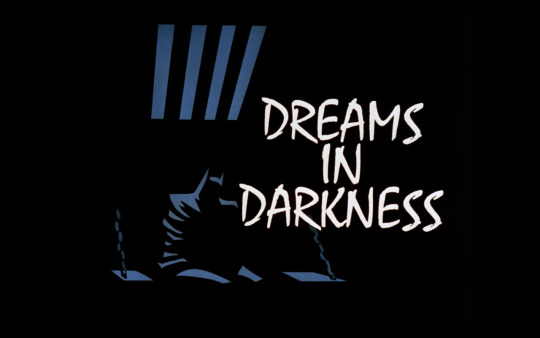
Episode: 28
Robin: Yes (Hallucination)
Writers: Judith Reeves-Stevens and Garfield Reeves-Stevens
Director: Frank Paur
Animator: Studio Junio
Airdate: November 3, 1992
Grade: A
Arkham Asylum sucks, doesn’t it. BTAS makes it pretty unclear whether criminals escape or get released most of the time (legally or illegally). But sometimes we are given an x-ray of the inner-workings, and it pushes away any hope that Gotham City has a way of cleaning up its reputation. The last time we had an episode featuring the Scarecrow, we found out that the Scarecrow was supposed to be contained, but a sketchy guard was hiding the fact that he actually was not in his cell. I’m not sure how long that charade could have been kept up, but for the Scarecrow, I doubt that mattered too much, right? Ironically, though, you would think the last thing an escaped patient would want to do would be to wear their infamous costume, stay in the same city, and cause a lot of recognizable trouble in an area as public as a college campus, but we are not exactly dealing with the sane here… This time, only a few episodes later, Scarecrow has somehow gotten out of captivity again. But instead of going all trick-or-treat at sports games, he opts to keep his activities hidden in the shadows below Arkham. There is an old George Carlin routine where he explains how theoretically, living next to a prison ought to be fairly safe. After all, an escaped prisoners are certainly not about to hang around, they’re going to get as far away as possible! Scarecrow may be crazy, but he also seems to be quite intelligent. He was a college professor as some evidence. He probably knows that one of the last places the police would look for him would be under the floor boards. And even here, he hides in the dark, giving orders from the void we so often see cloaking our characters on this show. On top of this, he speaks with a much more menacing voice than before, and at first I thought it was a different voice actor. But no, it is still Henry Polic II. Andrea Romano must have figured out how to actually make the master of fear the least bit intimidating, and it’s about time. Scarecrow for some reason took a while for them to figure out, with him being incredibly goofy in his first appearance, merely spooky in his second, and now incredibly sinister-seeming. Even his mask-design is ever-so-slightly different, although the difference in effect is negligible. What I appreciate more is the difference in his body and posture. Nothing to Fear portrayed him as moving in a very floppy, bouncy fashion, like a Scarecrow might in a little kid’s “Happy Halloween” cartoon special. His body now is angled quite nicely, and he almost stands the way a living corpse would. I’m glad Scarecrow went out on a high note, for the most part (as this is his last major appearance in Batman TAS). Don’t worry, that does not mean that this was his last major appearance in the DCAU!
When the episode starts, we do not know that the Scarecrow will be involved. We get a shot of some Arkham employees talking about a “new patient” who was experiencing some hallucinations. When the cell door is opened and the lights are turned on, we see that it is Batman of all people! When you are not even a minute in, and this is what the episode brings us, it’s like, “Wait. What the hell happened off screen before the show started exactly??” The show immediately plays with our expectations, setting up a mystery and leaving us unsure of whom to trust. We’ve been with Batman for 28 episodes now (plus a pilot), but we also know that he is perhaps not all mentally there, much like so many of his foes. Witnessing him bound in a straight jacket and being treated by doctors is hardly outside the realm of realistic possibilities! But we also know that something screwy is certainly going on, and the way the doctors talk, it’s harder to trust them then it is Batman.
Batman desperately attempts to explain what is going on to the doctors, and asks them if they contacted the people they were supposed to contact, but all he gets as a response is, “He needs more time. See that he’s not disturbed.” GAAAHHHHHH. Pet peeve! I hated as a kid when I would try to explain something, yet no one would take me seriously. It’s infuriating! The doctors act like they care and they are there to help, but ultimately, them listening to what Batman is saying is all an act! They are not hearing the supposedly sane words that they want to hear, so Batman’s garble is meaningless. That has got to be so frustrating, especially given the fact that Batman is trying to save the city from an underground threat!
After this scene, we get some narration done by Batman himself, and this subtly lets us know that, no, we didn’t miss anything, and that it will all be explained by the end of the episode. Batman narrating is also super badass. It would have been real easy to make it cheesy, but Kevin Conroy knows how to deliver. The narration also assures us that Batman is not the crazy one, because his words sound confident (despite showing deep distress) and they make sense. He isn’t talking like a crazy person would talk. We are about to do something that those doctors were not willing to do, and that is hear him out. The narration leads us to a flashback scene (with an awesome music score) where Batman attempts to stop some thugs from messing with the Health Spring Spa’s drinking-water supply, but he ends up being exposed to this red gas that the thugs were going to pump into the pipes. A voice on the thugs’ communication unit also mentions that Batman is “right on schedule”, so we know that this gas was all-too deliberate. This hear helps us piece together the puzzle of why Batman could be locked away. It obviously has to do with the chemicals that he inhaled, but what are the details? And who is behind it? It becomes more obvious as Batman looks up at his screen during a flashback and sees the reflection of the Joker walking toward him. Turning around, he realizes that it is actually Alfred who was approaching. Obviously concerned, he sneaks into a doctor’s office and allows Dr Wu to examine his blood. Apparently the hallucinations are set to get much, much worse, putting him in a state of psychosis. This is where he understand Batman’s intensity earlier in the episode when talking to the Arkham employees. Not only does he need to stop Gotham’s entire water supply from being poisoned by this gas, but he has limited time before he himself goes completely off the deep end. And that brings us to perhaps the greatest thing about this episode.
In Nothing to Fear, we got some fear-hallucinations, triggered by Scarecrow’s toxin. And they were, well, nothing to fear, honestly. We got the image of Bruce’s father’s floating head, telling him that he disgraced the family name for a couple of seconds. It served the plot of the episode, but the weight of it wasn’t exactly felt. We got another one where Bruce’s father turned into a skeleton-like figure, but again, it didn’t do a lot for me. The hallucinations seen in Fear of Victory were a lot better, but they still weren’t the best of the best. Dreams in Darkness, though, this is the Pink Elephants episode. It’s the peyote-in-the-desert episode. It’s the Squidward in Clarinetland episode. The hallucinations that Batman experiences are incredibly intense for a show appropriate for children, the most intense one being the giant pistol that goes off, representing the murder of Bruce’s parents. This is accompanied by bloodcurdling scream from Batman that gives goosebumps. The sequence is incredible well-done, but there are several more that we get to experience. If you are into bizarro sequences in animation, this is the episode where BTAS did a bunch of them, and I would say it is worth checking out just for that. But add in some other great things like a good mystery, the Scarecrow at his best, some awesome atmosphere, etc, and it is extremely worth checking out.
The episode even managed to fool me at one point, despite having seen it before. There is a point where the doctors inject something into Batman to sedate him. I was thinking we were gonna figure out that the stuff being injected was actually more fear-toxin, and that they were working for the Scarecrow. But no, as far as I can tell, they were legitimate doctors, even if their competence wasn’t that high. Hell, they question why Batman would think that Scarecrow might have escaped, when just four episodes ago that very thing happened. Jeez, guys. Even if they were new doctors to the place, you’d think they’d be informed that Scarecrow is a slippery one. How can anyone have confidence that Arkham Asylum is a safe place for criminals to go?
The episode of course ends with Batman facing his fears and defeating Scarecrow. Scarecrow is no match for Batman in a physical fight, and it probably brings him back to the glory days of high school where jocks beat the shit out of the nerds (that’s a joke, I was a huge nerd/geek in high school who stood no fighting chance against anyone). I loved how every time Batman would suffer a hallucination or face a new, scary challenge, he would simply keep on trucking. He would get done going through something absolutely terrifying, then stand up and calmly move forward. It was a situation where Batman knew that he had no choice, and that if he didn’t do this, then it wouldn’t matter anyway. Gotham would be up the creek without a paddle. At least until the military got involved. He even put off his own treatment (which would put him out of commission for a couple days) until after the Scarecrow problem was solved.
Check it out if you haven’t! Of course, my words can only do the show so much justice, so take a look at this episode’s screenshots! Is this an excuse to stop writing? Maybe… I’m just tired of being behind on these blogs… I’m gonna try to bust out a few of them tomorrow. It’ll put a lot less stress on me…
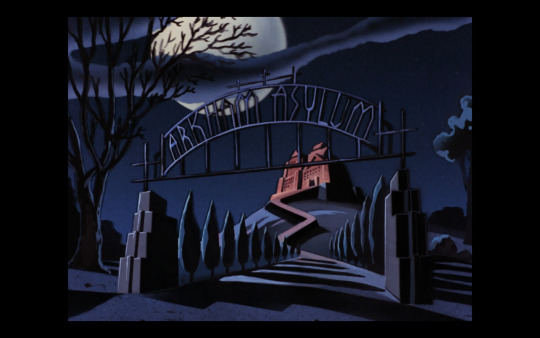
Had to use the Blu Ray footage this episode. But it all looks pretty nice, so enjoy some high def!

A twist beginning can be just as powerful as a twist ending. We also don’t often see Batman in such a powerless situation. Like Bugs Bunny (but with a completely different approach), he always exudes a sense of control.
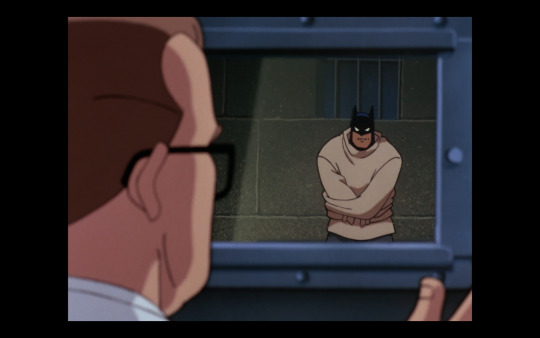
How do animators get this blur effect? When the camera shifts focus?

The lighting from the window is angled gorgeously. It’s also a shot that makes you wonder how the hell Batman is ever going to escape (Char gave me this insight).
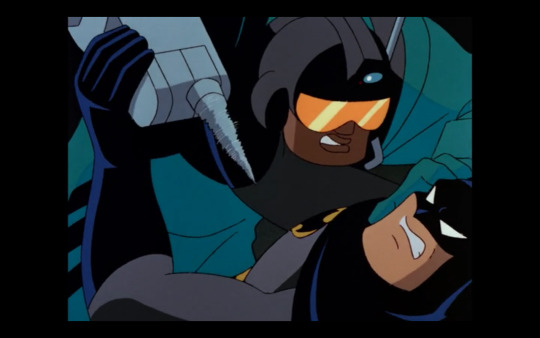
It’s not every family cartoon where you see someone about to be drilled through the chest.
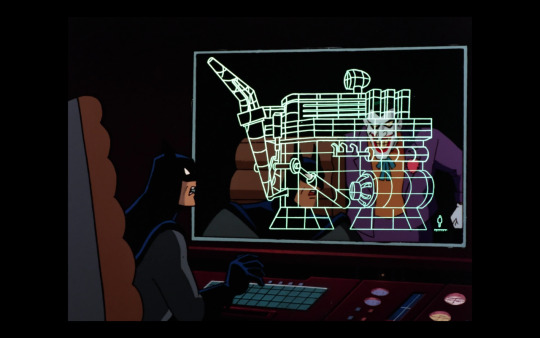
As the Joker suddenly appears as a reflection on the screen, we don’t get an dramatic music or anything. So when we see that it’s actually Alfred, it makes us feel almost as silly as Batman for worrying.
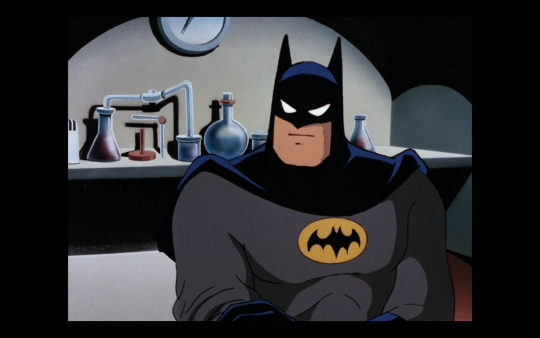
A pretty good shot of Batman’s face, but the rest of his body seems off to me. Also, this is our first time seeing Batman in-costume getting help from a professional like a doctor.

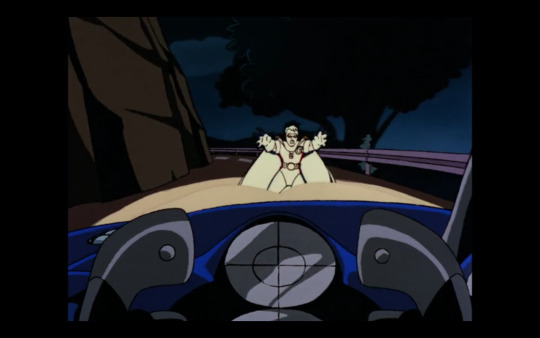

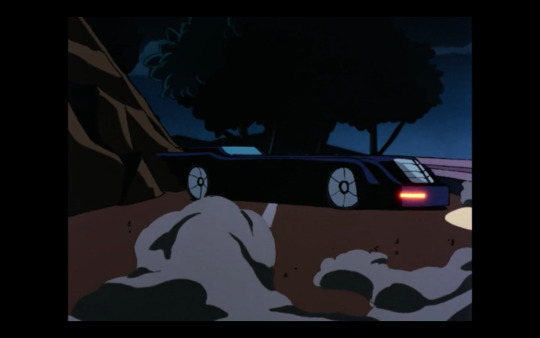


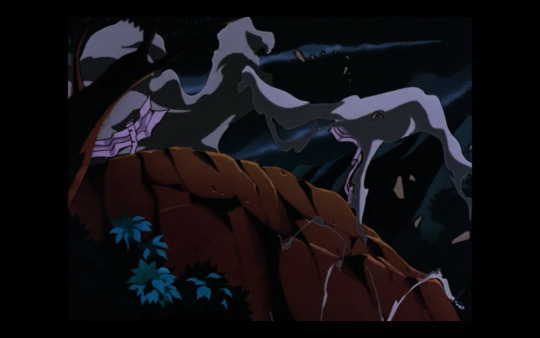
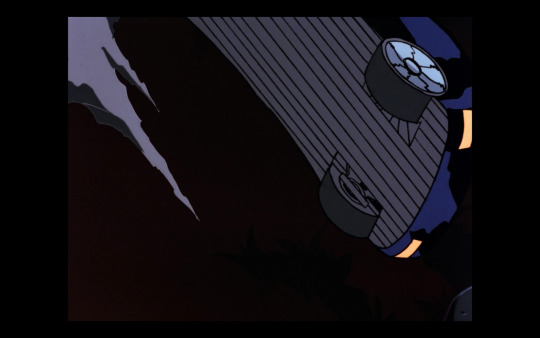
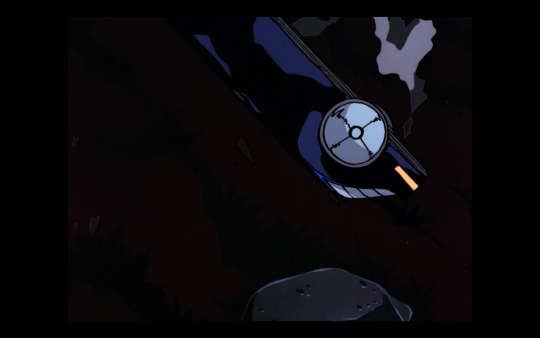
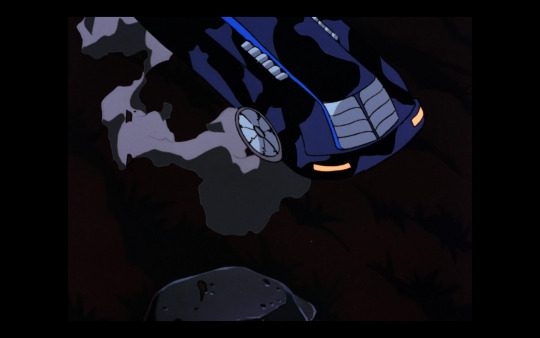

Well animated crash sequence, ending in a shot of the asylum as two doctors sprint out, heading for the crash sight. Great transition.

So as Batman talks to the doctors, I noticed that one of them refers to the Joker as Jack Napier. Is that his actual name in this show? Or is it merely an alias (and one of many?). No spoilers, I wanna find out through the episodes and comics!

Here is what the Scarecrow is looking like this time. Compare this to his last appearance:

His design is certainly shifting toward the more angular, streamlined look of future DCAU shows.

Is that sweat or a tear, Batman????

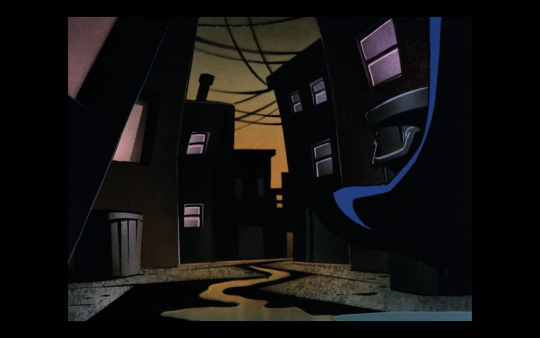
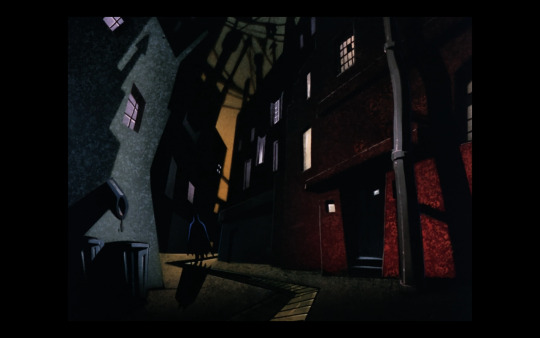
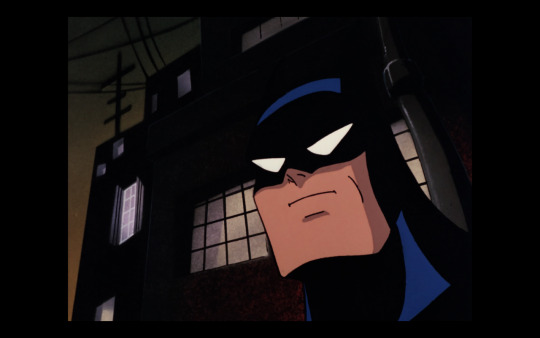



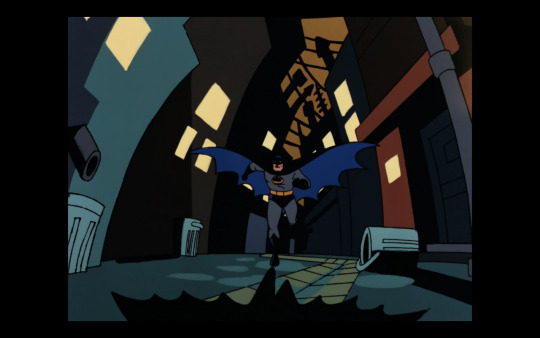
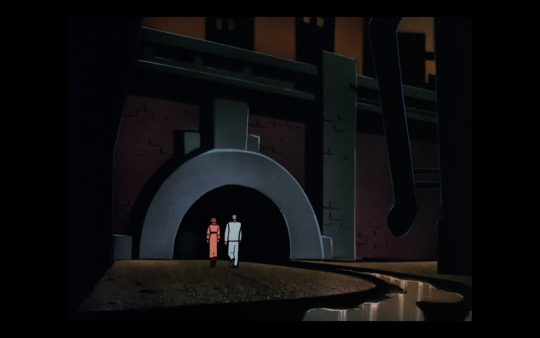
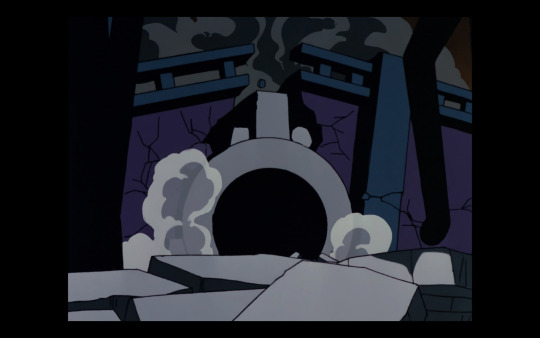
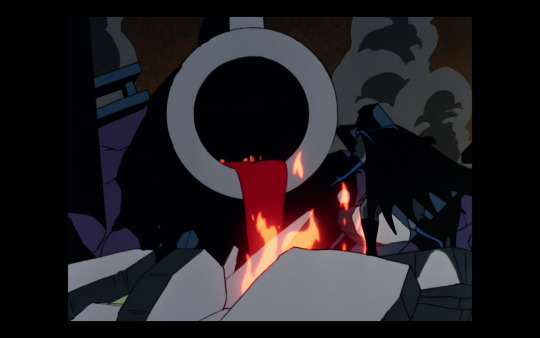

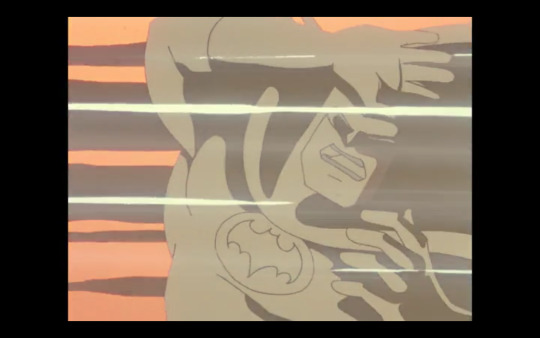
One of the hallucination-sequences that was so powerfully sad and ctreative (Char). Instead of simply leaving the gunshot to our ears, we see the tunnel they enter morph into a giant gun, and blood runs out of it. I don’t want to quite call this personification, but it is a very warped interpretation of what happened last night and it gives us somethin far more interesting than anything offered in Nothing to Fear where it was much more straight forward.

Scarecrow’s clock is very cute.
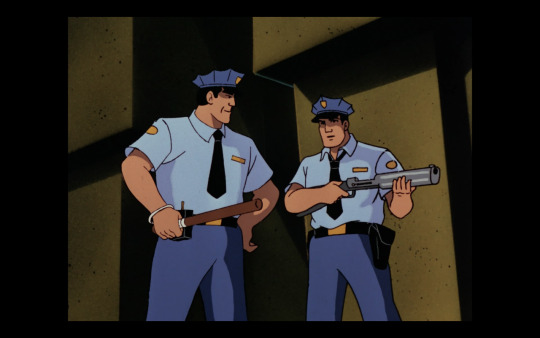
I like how they both look at each other after missing Batman with a traguilizer dart. Like, “Good going, Frank.”
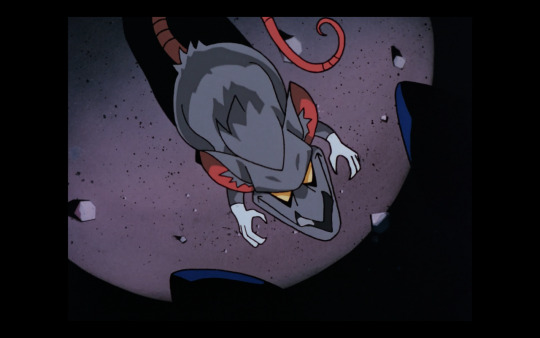
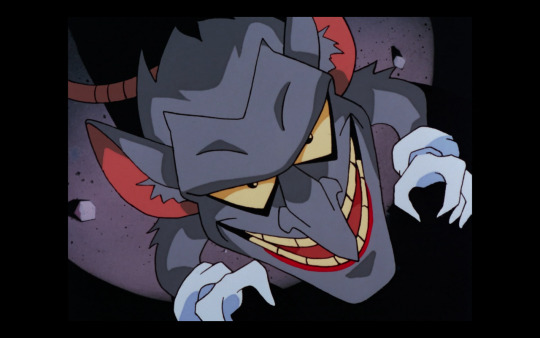


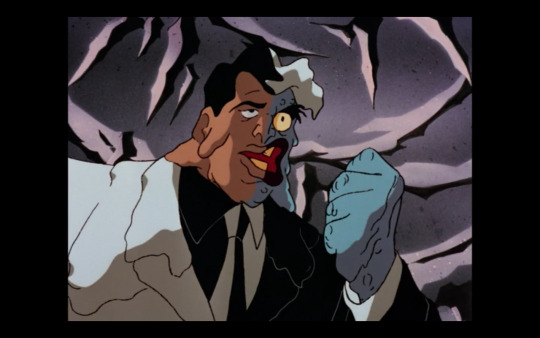
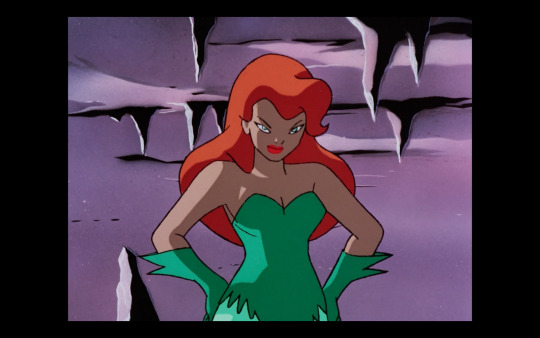
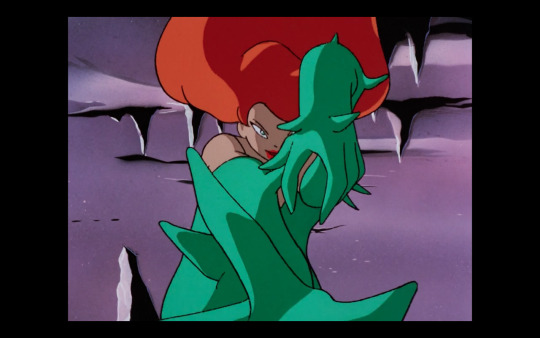
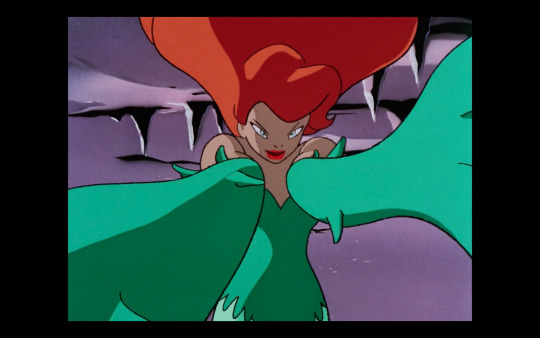




Batman was trapped in a mental hospital where most of his arch nemeses are also being held. That has to keep a guy on edge. No wonder he’s having these particular visions. Robin and Alfred’s voice actors do a great job here sounding like evil versions of their normal selves. It’s all quite unsettling.
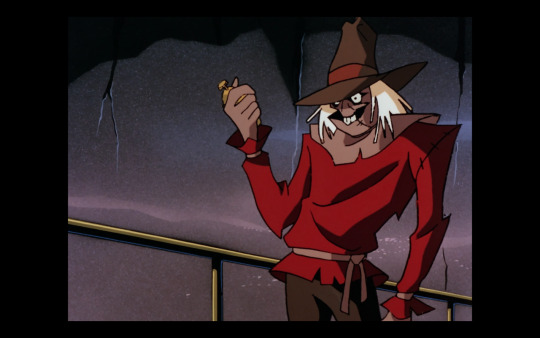
Look how great he looks!!!
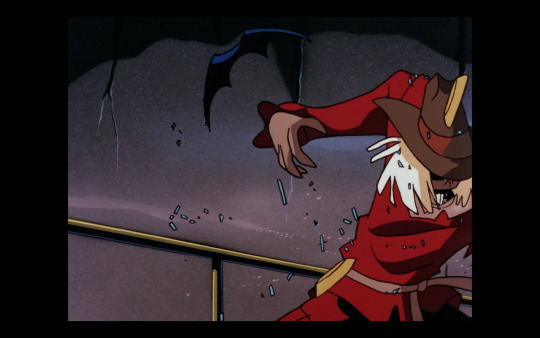
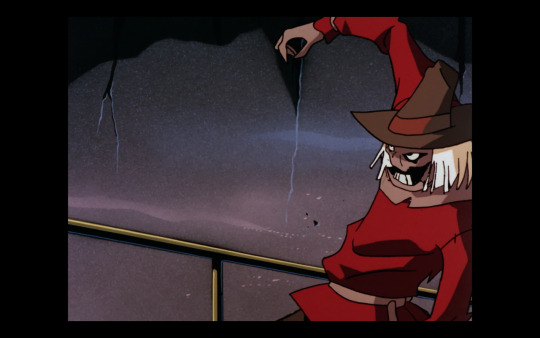
This batarang moment was dope. Look at those two stills. This is Studio Junio, the same ones who animated The Underdwellers.
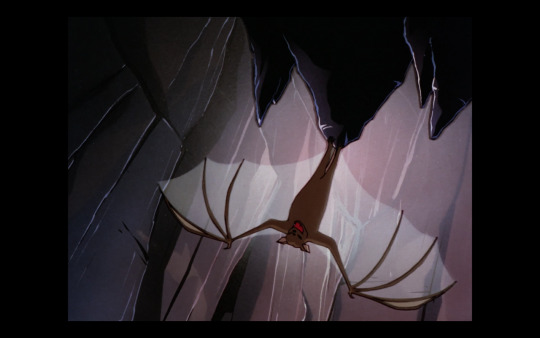
That’s all for this episode!
This show has the ability to make so many viewers feel young again. It’s no demetrite, but it gets the job done... Join us next time!
Char’s grade: A
Next time: Eternal Youth
Full episode list here!
#dreams in darkness#dc animated universe#dcau#batman tas#batman the animated series#btas#scarecrow#arkham#arkham asylum
6 notes
·
View notes
Photo
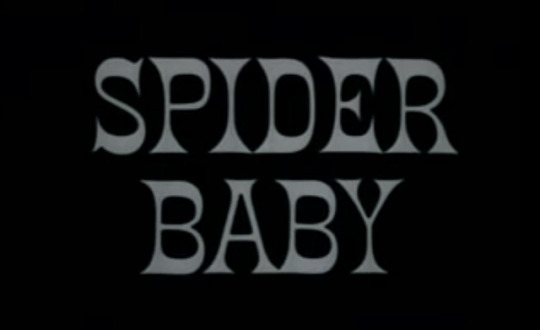
Spider Baby, or the Maddest Story Ever Told
You will find this movie under many titles, including Cannibal Orgy and The Liver Eaters, but Spider Baby is probably the most appropriate for both the content and the tone. You'll also find it dated to both 1964, when it was shot, and 1967, when it was released (after being auctioned off when the producer went backrupt shortly after the film was finished). For our purposes, what matters is that it stars Lon Chaney Jr from The Indestructible Man and Sid Haig from Wizards of the Lost Kingdom II, and the cinematographer was Alfred Taylor, who did the same job on The Atomic Brain. The latter explains a lot.
The Merrye family suffers from an incurable genetic disease that causes progressive degeneration of the brain starting at around the age of ten or twelve. Sufferers regress into a childlike state before finally being reduced to drooling, mindless cannibals! Despite this, the family seems to have been living quite happily in isolation, looked after by Bruno the chauffeur, until one day some cousins turn up looking for the family fortune. Realizing they could be taken away and separated, the family tries to convince them to leave, then to scare them away – and finally decide they're just going to have to kill them.
Spider Baby has a reputation for being a cult classic, which puts it in the odd position of appearing on several lists of The Worst Movies Ever Made while also having a one hundred percent rating on Rotten Tomatoes! I have to say, the movie is pretty bad, but at the same time, it's also mesmerizing. There are bits that I think you're supposed to laugh at, bits you're not supposed to laugh at but do anyway, bits that fail spectacular to be scary, and bits that are creepy as shit.
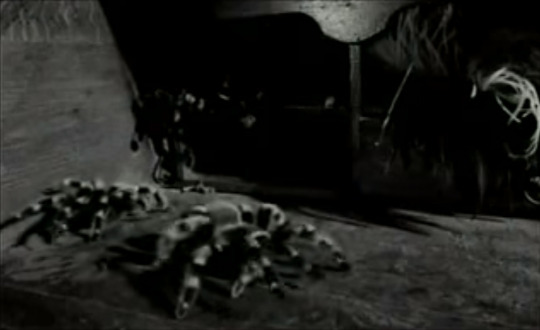
At a glance, Spider Baby comes across as an embryonic form of the 'crazy family in an isolated house' movie, a precursor to The Hills Have Eyes or The Texas Chainsaw Massacre. It probably is, but there's one important difference: while movies like that see the fucked-up world of the family through the eyes of an outsider, in Spider Baby the Merryes themselves are our point-of-view characters! We meet them when a delivery man arrives at the house, only to be stabbed to death by a young woman who tells him that he's a bug caught in her spiderweb! With the 'straight man' out of the way, we have to meet the family on their own terms.
The youngest is Elizabeth, a spiteful but mostly normal girl of indeterminate age (it's really hard to tell how old the 'children' are supposed to be, partly because they're supposed to be mentally regressed but also partly because we're all used to actors in their twenties and thirties playing teenagers – actress Beverly Washburn was twenty-four). Middle child Virginia dotes on her two pet tarantulas, Barney and Winnifred, when she's not murdering the guests or kissing skeletons goodnight (Jill Banner was twenty-one). The Eldest, Ralph, is a non-verbal sexual predator who enjoys raw meat (Sid Haig was twenty-eight). Three more, who have degenerated into sub-human monsters, are kept locked up in the basement.
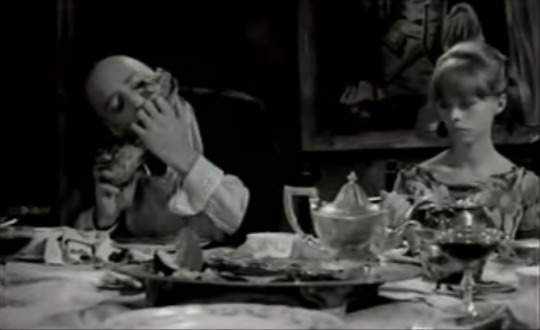
This menagerie of weirdos is cared for by Bruno, the family chauffeur, who swore an oath to their dying father that he would look after them for as long as is necessary. Lon Chaney Jr. actually gives a really good performance in this role. We can feel that he loves the children and really believes it's better to keep the family together at any cost, and is very much afraid of what might happen when Emily and Peter meet them. When he and the family clean up and try to look a little more normal for their visitors, our sympathies are with them. We are right with them in resenting the intrusion, and anticipate the fates of Emily and the lawyer with thoroughly nasty glee.
Besides Lon Chaney Jr., the movie has one other really effective actor, Sid Haig. If his performance doesn't make your skin crawl, especially when he's creeping down the wall to look through Emily's window, then you should probably see a dermatologist. The movie amps up the creep factor in other ways, too – the music is pretty good, referencing The Itsy Bitsy Spider in a way that's both chilling and funny. The unbelievably awkward dinner scene has no music at all, which makes for a sense of claustrophobia. The house is decorated with taxidermied birds, which I found pretty creepy in themselves, although this may just be my personal dislike of taxidermy. Naturally, one of them turns out to be a real bird and scares the bejeezus out of the lawyer. Too bad it's so obvious, which ruins the jump scare when the animal moves.

The movie's theme is fairly well-developed, too – it's about humanity's fear of our own inner monsters. For as long as we have recognized that we are qualitatively unlike the rest of the animal kindom, we have worried about what might happen if whatever causes that difference were to cease to function. Might we really all be just one head injury away from savagery? The family members of different ages represent stages in the disintegration of an individual's humanity: first, like Elizabeth, they become mean. Then, like Virginia, they become murderers. Third, like Ralph, they are torturers and rapists. Finally, like the creatures in the cellar, they are cannibals. One by one, all taboos are broken, and the thin verneer of humanity is stripped away to reveal the monster underneath.
The final taboo is incest, which we are told has occurred in the Merrye family and has made the syndrome worse. It is notable, however, that there is no hint of it among the characters we actually meet – Ralph never tries to molest his sisters, and they show no fear of him doing so. For all her love of knives, Virginia never tries to hurt Elizabeth or Ralph, either, and none of them ever tries to harm their surrogate father, Bruno. Demented as they are, this little family is a loving one, and they save their violence for outsiders. This is a big part of why the three children remain endearing characters even as they commit unspeakable crimes. Their familial love is the one nugget of humanity they have not yet lost.
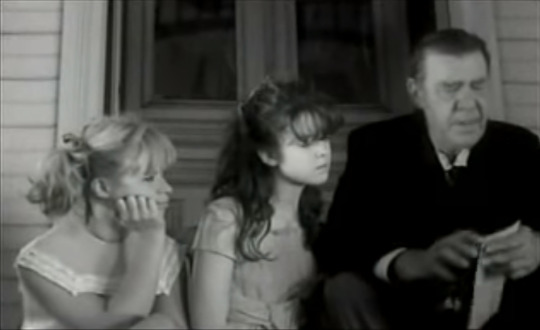
Another fear that Spider Baby takes advantage of is the fear of what's in our genes. This, too, is very old. Long before we understood the basis of it, we knew that some diseases and conditions ran in families. Hemophilia is a good example, as are things like ectrodactyly ('lobster syndrome'), and like Merrye Syndrome they become more pronounced in small gene pools – witness the prevelance of polydactyly (six fingers) among the Amish. Until very recently it was impossible to tell if a baby had inherited the flawed genes until it was born, and pregnancy in such families was a roller-coaster of hope and terror. Spider Baby takes it one step further, positing a syndrome that does not manifest until late childhood. How much more stressful this must have been for the late Titus Merrye, having to wait until his children were ten or twelve before learning whether they'd inherited the condition that he was lucky enough to escape? No wonder he died young.
Worse still, such conditions can hide in a bloodline for multiple generations without ever manifesting, until somebody finally loses the genetic lottery. This is addressed at the end of the movie, when we get Cousin Peter's happily-ever-after ending with his wife Anne and daughter Jessica – who is fascinated by spiders. Is she showing early symptoms of Merrye Syndrome? The movie certainly wants us to think she is, in which case Peter should not have taken it for granted that he wasn't a carrier. None of us can.
What about the sufferers themselves? With conditions like ectrodactyly, it is with a person from birth and he or she will learn to live with it, never knowing anything else. Among the Merryes, however, a child would grow up seeing aunts and uncles who must be locked away, and perhaps watching older siblings decline, all while knowing that a similar fate may or may not be awaiting them – there's no way to tell until they reach the age of onset.
While Spider Baby gives us a lot to think about, it never really gels. Except for Lon Chaney Jr. and Sid Haig the actors are nothing to write home about, and there's plenty of cheese to go with the ham. The sets always look like sets, the prop knives look like prop knives, and for every honestly uncomfortable thing (like Peter enjoying his dinner of toadstools and roast cat) there's something that falls flat (the ear in the box is no more than an anticlimax). It's still a hell of a lot of fun to watch, though, mostly because of the perfect balance struck by never making the awful characters so awful that we don't like them in spite of it all. It's full of scenes and lines I would have loved to see the Brains run with, and a great movie to show your friends and munch popcorn while you watch their reactions.
If you're interested, there is a real-world medical condition that is strongly reminiscent of the fictional Merrye Syndrome. This is Fatal Familial Insomnia, a genetic disease in which a toxic protein, called a prion, slowly accumulates in the brain over the course of decades. Symptoms don't start to show until adulthood, but as the prions build up the sufferer experiences hallucinations, memory loss, convulsions, dementia, and a complete inability to sleep. It runs in families, but you can also acquire it by random genetic mutation – and once it sets in, you have no more than two years to live.
Sweet dreams!
10 notes
·
View notes
Text
Metropolis (1927)
With a running time of over 2½ hours — plus the only sound being music — this seems like an insane amount of time to devote to watching a silent film from over nine decades ago.
It’s not. It is totally worth your time to locate the ‘restored’ version which came out around 2010. The narrative is clear, the acting over the top but forgivably so, the special effects eye-popping, and both the art design and cinematography excellent. It really doesn’t feel like 2:33 at all.

Being one of the most expensive movies of the time, costing around 5m Reichsmarks, this film nearly sent its studio, UFA (Universum Film), into bankruptcy. Adjusting for inflation, the budget for Metropolis ran around $200 million ($ as of June, 2007). Given this was only a decade after the First World War, and Germany was only barely getting itself on its economic feet, this was simply an insane amount of money to spend on a film. Adding to that insanity was the fact it took almost a year and a half to shoot. In the end, it was worth it: this was the first film ever to be registered in the “Memory of the World-Register” of the UNESCO in 2001.
I have cut a massive amount of text discussing how bits were edited out and thought lost and then found but they were in awful condition and they didn’t know for sure what order things should Abe in so they…
You’re welcome.
If you really feel the need to lose the amount of time I just saved you, Google “Metropolis edited lost Buenos Aires” and you’ll have more than enough material to go down a rabbit hole for a good hour or more. Here’s a place to start: https://en.wikipedia.org/wiki/Metropolis_(1927_film)#Restorations
The influence of the film is almost too long to attempt to list, but here are a few things to consider, some of which even surprised me when I looked into the matter.
The look of the robot in the story (and seemingly the first time an automaton was pictured in a film) is directly comparable to the appearance of C3PO from the Star Wars films. The machine that transfers a soul into the robot has been duplicated a gajillion times, including The Fifth Element.
The mad scientist / inventor Rotwang's mechanical right hand was later imitated in Dr. Strangelove or: How I Learned to Stop Worrying and Love the Bomb (1964).

Have a look at that city and tell me you don’t see Blade Runner? Also, consider the fact that all of those vehicles (on the ground and in the air) were animated using stop-motion techniques. Every single one of them was nudged a little bit in the direction desired, then another frame was shot, then every single one of them was individually nudged forward a bit, then another frame was shot… it took a week for ten seconds of film.
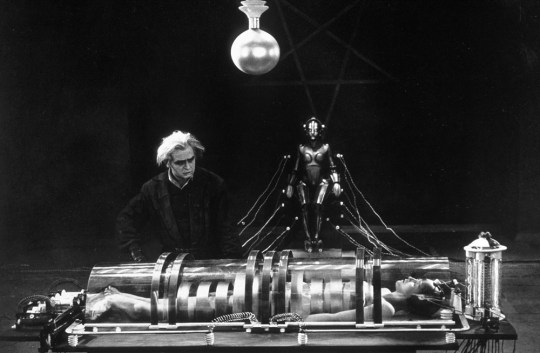
Look of the lab: Frankenstein’s Monster
The story of man’s fight to be both a valuable part of society as well as valued for being human is a story as old as time itself, and something this film really hammers home. It’s pretty heavy-handed at times, and its naïveté about how the Industrialist and Labour interests being mediated by the heart / soul / love for others in a community is… well… sweet, I guess. Thinking about it later, Herr Lang said that he probably wouldn’t have taken such a simplistic approach to the matter. Given he was a much older man at that point, the mild regret is hardly surprising. Who but a young man could make a film such as this with its heavy symbolism?
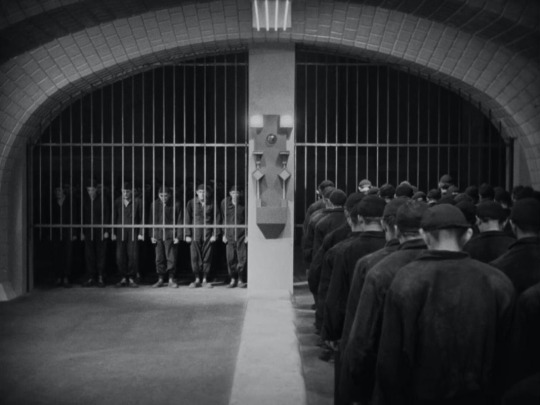
With the ‘new industrial age’ dawning at this point (arguably, at least), the movie tries to grapple with Machine v Man and provides two answers: build a mechanical human (the robot who takes on the soul of Maria), and the epigram-referencing bridging notion. The former doesn’t work — or does it work too well, hmmm? — and the latter works in this story but cannot be considered as a serious solution today. Even if you consider the problem at its most basic, balancing work, life, mental health, productivity, economic vibrancy, and social good is hardly something one can suggest the solution is ‘being compassionate. The Dali Lama urges us to bring compassion into everything we do, for it is that which makes our lives full and ride both want and sadness from our lives, yet want is something which economic vibrancy requires to exist; so the two are at odds with one another.
The film is in one sense a thriller / mystery / romance / futuristic dystopian tale with romantic elements (and perhaps some occultism, but nearly all of the intended aspects of this were edited out of the script before production), with some calling it ‘the first SF film.’ There’s a French movie called A Trip to the Moon (or something) which was released decades before Metropolis and puts the lie to that notion, but it could be argued that this is is the first full-length SF masterpiece. The mere fact I’ve banged on and on about it this much certainly says it’s more than just a puff-piece.

The performances are very much over the top, as mentioned above, but it’s a silent film; this was the style at the time. We cannot hear the voices of the actors, so their faces and gestures needed to convey the excitement or horror of their ‘words.’ You get used to it fairly quickly.
Alfred Abel who plays the Master of Metropolis Joh Fredersen is particularly restrained, with some really nice moments where you see him thinking and caring about what happens.
Also a treat is Brigitte Helm as Maria, but for entirely apposite reasons: she’s both super restrained but passionate in her role as ‘Maria Prime’ (if you will), but when the ‘Man Machine’ transforms into ‘Maria Machine,’ she is one quirky, twitchy mass of mechanical mayhem! She’s great! Her ‘Erotic Dance’ is tame by today’s standards, but you’ll see all sorts of things Madonna, Paula Abdul, and a host of others have ripped off over the years.I’d wager serious money that I’ve seen local burlesque performers do some of her moves and I completely missed it at the time!
Honestly, this film never ages, and if you haven’t seen it, you are missing out on an absolute gem.
★★★★★
0 notes
Text
Gotham 04X02, ‘The Fear Reaper’
Things I am looking forward to this episode: Jonathan’s antics, and finding out how the hell Barbara’s still alive. Oh, and Alexander Siddig’s face. Things I do not care about: just about everything else. This is Gotham.
[TW: Torture, abuse, patient abuse, suicide ideation, all the nasty shit implied about Warden Reed turning out to be one hundred percent true]
- First off, last week, I picked up on there being something messed up about Jonathan’s relationship with Warden Reed that went beyond the man being willing to literally sell him to a couple of goons. I had at the time assumed that this wasn’t the first time Reed had done something like this to him, but some other bloggers, when they posted their commentary of ‘Pax Penguina’, raised a likelihood that, while worse, unfortunately also happens to make a lot more sense. I’ll be interested to see if the worries they raised play out in ‘The Fear Reaper.’
- We open at the old Crane house. Sure took you long enough to get there, Gordon (Though since he’s talked to Merton, I’m assuming—hoping—that they know now that Jonathan didn’t go with those guys willingly).
- Okay, when I saw Grady up on that scarecrow frame, I laughed. I cackled like the inappropriate blogger I am. He’s an asshole and he had it coming, but it’s also just a funny image. Like, how did Jonathan even get him up there? He’s a skinny teenager who, given what a shitshow Arkham is, probably hasn’t gotten too much exercise over the past couple of years, so he’s probably quite weak. Also, Grady’s bigger than him, and probably thrashed around a lot. So… how does this work?
I do have to note that Jonathan did not kill him in favor of doing this to him, though. I note this because he is the villain of the episode pitted against a hero who has committed murder more than once. Okay, granted, Grady seems to have been tied up crucifixion-style, which would have killed him eventually because his lungs would collapse, but Jonathan’s been shut up in Arkham since he was about fourteen, so I’ll bet he doesn’t know that. So, things to keep in mind for the rest of the episode: Our hero has a body count, and our villain, as of the Grady discovery, does not. I do wonder if Jonathan’s going to kill Warden Reed. The episode might try to frame it as a point of no return, but let’s be real, after everything that was both presented and implied about him and his relationship with Jonathan last episode, if anyone has it coming, it’s that slimy fucker.
- Bruce in lock-up, while Gordon tells him that they will be talking about this. And Grady screaming in his cell.
(I love that Bruce’s go-to excuse was that he was looking for Selina.)
- Next, Arkham at lights out, inmates being strapped down to the beds, while Reed is setting papers on fire. Jonathan shows up—scythe in hand—and asks him if he’s covering up his dirty footprints. Oh, shit; the undertones are playing out. Is the show going to do something with this?
- This is satisfying. Well, not the “Jonathan Crane’s dead” part, but the other part. And Reed’s looking at his gun, tried to kill him, but Jonathan got him with the gas first. And does not kill him, I’ll add.
- We’ve confirmed also that Jonathan was in Arkham the whole time since we saw him in Season 1, presumably while Strange was in charge, too. We’ve also confirmed that he wasn’t given any kind of real treatment or therapy, that no one even tried to help him, that he was instead subjected solely to ice baths and electroshock. In a context that makes it clear that this was meant as torture, and not treatment. Great.
- We are going straight into cartoon villain territory, though, if in an “abused teenager violently lashing out” kind of way (It’s very obvious that it’s a child under all those rags and not an adult, even as he’s being hella menacing). I wonder if Jonathan believes everything he’s saying about dear old Dad when he’s not in an altered state of consciousness. I’m not saying it’s impossible for him to still love his dad and have complicated feelings about him, but all of this together is just a little much.
- (Show, if you’re trying to make me not feel sympathetic for Jonathan, it’s not working. Him gassing the patients to make them more volatile is bad, certainly—I don’t approve of it—but it’s nothing on the scale of what certain other characters in this show have done. It feels like a deliberate ploy to make him less sympathetic and more monstrous, instead of something he might have done organically, and I don’t appreciate being manipulated this way.)
- “Play nice.” “No.” For once, I’m inclined to be sympathetic to Gordon, since Oswald dragged the fucking press down to the precinct to bear witness to their argument.
- I’m not surprised Oswald wants Jonathan found, not after his public humiliation last episode. This does ramp up my sympathy for him, though, which I wouldn’t have thought possible, because Jonathan’s already in the top five of most uncomplicatedly sympathetic characters on this show, and having the local mob boss out for his blood just makes him even more sympathetic, because even as he’s gearing up to raise hell, I worry about what Oswald might do to him.
I am kind of interested to see how Oswald might react if he found out the whole story regarding Jonathan. If anyone might feel sympathy for the kid, it would be him, if only because the “got shut up in Arkham and had a bad fucking time” part of his story would ring a lot of bells for Oswald Cobblepot.
- “Like a chicken?” Jesus, Harvey; right after you told Gordon to play nice?
- And now Oswald has moved on to the list of people who uses Jonathan for his own ends, in this case using his name as a ploy to prove the GCPD is toothless.
- Selina and Tabitha show up at Barbara’s place. “No way.” Indeed.
- Barbara’s not quite as she was, but I wasn’t expecting her to be.
- Barbara still manages to be a better person than Tabitha.
- Alfred’s right; Bruce isn’t ready.
- Arkham being played as a horror movie when it’s a bunch of mentally ill people who’ve been fear-gassed is kinda gross.
- They’re not shying away from the fact that Gordon did kill Jonathan’s dad, though. I appreciate that. (I am kinda surprised he even recognizes Gordon, given the state he was in when Gordon got to him.)
- Oswald’s still being awful to Ivy.
- Barbara’s wonderful in how creepily unflappable she is. Oswald’s right in pointing out how unlikely it is she could have financed all this herself. (I’m thinking Ra’s al Ghul, and I’m thinking Barbara had a date with the Lazarus Pit at some point.)
- Back in Arkham. Jonathan confronts Gordon. He does look suitably horrified when he realizes it’s Jonathan, and seriously, how much of this shit Jonathan’s saying about his father does he even believe when he’s not in an altered state of consciousness?
- Gordon gets gassed, and honestly, I do not care about whatever it is he’s gonna see under the influence of the gas.
- “What will you see? One of your victims, perhaps?” Yeah, Jonathan’s definitely still in there. You’re not fooling anyone, kid.
- He sees Lee having slit her wrists. “You destroy everything you touch.”
- Jonathan tries goading Gordon into suicide, using language that makes me wonder if he isn’t suicidal himself. Though when Gordon shakes off the gas’s effects with ~~~willpower~~~, Jonathan isn’t there, so I dunno.
- It’s both more and less than I was hoping for, but Gordon does appear to feel genuinely sorry for Jonathan. He sounds like he actually means it when he tells Jonathan he needs help.
- “My father thought I was weak. All my life I was scared little Jonny. But I will never go back to being that scared boy again.” Ughhh nothing this show does will ever make me not feel sorry for him. Not with such a horrific backstory and the knowledge that he was being abused the whole time between Season 1 and now.
- (I am deeply irritated that Gordon just shook off the toxins’ effects with ~~~willpower~~~)
- And Ivy has had enough of Oswald, it seems.
- Water neutralizes fear gas?????? Are you fucking kidding me????!!!!!
- I love Alfred’s face when Lucius comes by with the armor. It’s a combination of “Oh, thank God” and “Fuck you, Lucius; don’t encourage him.”
- Selina is definitely not digging Tabitha wanting to cut off one of Barbara’s hands. But she can’t do it. Mercifully. Selina still doesn’t dig it.
(There is definitely something up with Barbara, though. I can’t imagine her being that calm about possibly getting one of her hands chopped off under normal circumstances.)
- And Oswald just straight up says in front of the press that he’ll pay the police to work for him instead. In what world does this work properly, without you getting arrested by the feds for admitting on camera you’ll bribe people?
- Ivy’s looking for stronger substances than just her perfumes. Honey, that’s so not gonna work out well for you. Ivy, please stop drinking it. Ivy, please stop.
…Oh, that’s not good.
- Falcone, fair? Falcone had honor? Are you fucking kidding me?! How thick do your nostalgia goggles have to be for you to say something like that, Harvey?!
- Baby Batman away! (The costume looks better with a cape, but Bruce probably doesn’t need to deal with that until he’s got the other stuff down pat.)
2 notes
·
View notes